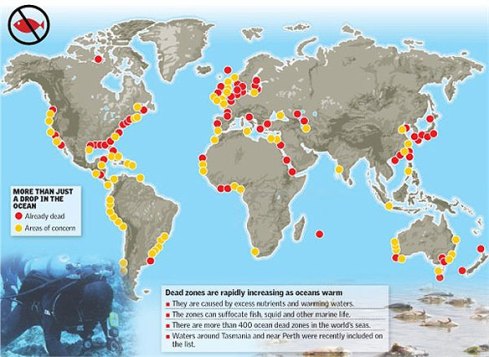The world’s first identified ocean “dead zone”—a watery region where a combo of nitrogen and phosphorous fertilizer runoff creates monstrous algae blooms that kill off everything in the water—was discovered more than 40 years ago at the mouth of the Mississippi River in the Gulf of Mexico. Today, more than 400 dead zones are growing around the globe; the number has doubled every decade.

No fish can live in the dead zones where fertilizer-polluted rivers dump into the sea. (Photo: Ho New/Reuters)
With that death-zone expansion in mind, new research conducted by the Center of Excellence for Coral Reef Studies in Queensland, Australia, has scientists extremely worried that the sea may face a mass extinction by the end of the century.
All of the oceans, say the study authors, have numerous dead zones, with particular hotspots in the tropical South Pacific, off southeastern Australia and China, in the Gulf of Mexico and off Namibia, in the Bay of Bengal, in the Baltic and Black seas and in the South Atlantic. Essentially, the problem exists everywhere rivers meet the sea.
Each spring and summer, the original dead zone in the Gulf of Mexico grows to roughly the size of New Jersey, spanning the ocean from Mississippi to Texas. Nothing in its reach can grow. Around the world, dead zones range in size from one square mile to 27,000 square miles. All told, dead zones now cover nearly 100,000 square miles of ocean, an area larger than the state of Oregon.
Why the boom? A familiar trio of problems: overfishing, nutrient runoff, and climate change. Too many people live and pollute too close to the sea and take its biggest resource (fish) without pondering the consequences.
According to the Australian report, now is not the first time the oceans have died off: “Declining oxygen concentrations have played a major role in at least four or five mass extinction events.” Those were due to meteor strikes or booms in erupting volcanoes, which killed off 90 percent of life in the ocean.
The authors of the new report believe that a similar loss of life could occur in the next 100 years.
“Climate change is driving changes to water circulation—so winds, strange weather patterns, have a consequence for how the ocean turns over and aerates and so on, and it’s the winds which are delivering a lot of organic compounds into the deep sea.
“At the same time, we are putting a lot of fertilizer off coastlines, those sorts of things are incubating these deep water anoxic zones.”
This would be the first time that the ocean died due to man’s influence; as the ocean warms due to a fast-changing climate these low oxygen zones will move closer to the surface and spread out along the continental shelves.
“Ocean ecosystems are in a lot of trouble and it all bears the hallmarks of human interference,” says the study. “We are changing the way the Earth’s oceans work, shifting them to entirely new states, which we have not seen before.”
“It’s mucking around with the heart and lungs of the planet—that’s essentially what the oceans are, a huge respiratory system. We damage them, the consequences could be very serious.”
Last season, during the BP spill, that very first dead zone in the Gulf of Mexico swelled to near-record size. With all that crude polluting the Gulf, could the dead zone get any deader?
The answer is no.



